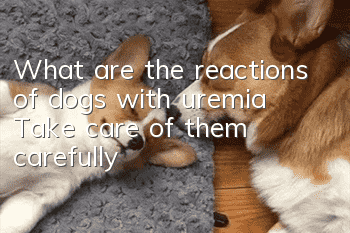What are the reactions of dogs with uremia? Take care of them carefully!

Symptoms of uremia in dogs
1. Due to damage to various tissues and organs of dogs, their clinical symptoms are also complex and diverse. The sick dog is extremely depressed, unconscious, sensory disturbance, lethargy, loss of appetite or exhaustion, vomiting, gastrointestinal inflammation, mucosal ulcers, diarrhea, bloody stools, intestinal paralysis, elevated blood pressure, cardiac insufficiency, pulmonary edema, congestion, respiratory Shallow and frequent.2. Due to metabolic disorders, affected dogs may show dehydration, low sodium and calcium and high potassium, phosphorus and magnesium. The non-protein nitrogen content in the blood is significantly increased, acidosis, and hyperlipidemia. Impaired glucose tolerance and vitamin deficiency. Hyperphosphatemia further causes abnormal calcium metabolism and vitamin D deficiency. Suffering dogs are often accompanied by osteomalacia and osteodystrophy, and may also develop secondary hyperparathyroidism. Due to the low immune function of dogs, they are prone to secondary infections.
3. Blood test: urea nitrogen is higher than 40 mg/100 ml, creatinine is higher than 4 mg/100 ml, and blood sodium, calcium, and carbonate are decreased. Serum potassium and phosphorus are elevated.
4. Urine test. The kidneys have the function of concentrating and diluting urine. In prerenal renal failure, the urine specific gravity is 1.025. Renal renal failure is 1.008--1.012, indicating reduced renal concentrating and diluting functions. In postrenal renal failure, the specific gravity of urine changes irregularly. Oliguria and anuria are symptoms of critical illness (under normal circumstances, dog urine output is 25 to 40 mg/kg of body weight per day).
Causes of uremia in dogs
Uremia is a sign of severe renal failure in dogs.1. Absorption of intestinal toxic substances, such as phenol, tyramine, phenylethylenediamine, etc., are absorbed from the intestine into the blood. Due to kidney failure and reduced liver detoxification function, the poison accumulates in the blood and causes poisoning.
2. Due to kidney failure, urea enters the intestinal cavity, is decomposed by intestinal bacteria into ammonia and ammonium salts, and is then absorbed into the blood, causing symptoms of nervous system poisoning.
3. The accumulation of toxic products from the decomposition of certain proteins, such as guanidine compounds, can inhibit the activity of certain enzymes (lactate dehydrogenase, ATPase, etc.) in the body, causing convulsions in dogs, and can also induce gastrointestinal tract disease in dogs. inflammation, pericarditis, bleeding and reduced immune function.
4. Acidosis occurs due to disorder in the excretion of acidic metabolites, causing changes in respiratory and cardiovascular activities and coma.
Treatment methods for dogs with uremia
1. General treatment. Administer sodium bicarbonate according to the degree of acidosis (detection of plasma carbon dioxide binding capacity), and select calcium-free infusions to adjust hyperkalemia. Supplement a large amount of amino acids, high-energy, vitamin preparations, etc. to improve hyperzotaemia. For dogs with prerenal uremia, administer furosemide 2 to 4 mg/kg of body weight, once every 8 to 12 hours. Or diuretic acid 1~2 mg/kg body weight, administered in 2 times. When neurological symptoms occur. Administer chlorpromazine 10 to 20 mg/kg body weight or phenobarbital 2 to 5 mg/kg body weight orally three times a day.2. Peritoneal dialysis. When blood urea nitrogen is 100 mg/100 ml, serum creatinine 10 mg/100 ml, and serum potassium 6 mmol/l, peritoneal dialysis can be performed. Dialysate is a calcium-free fluid. Intermittent peritoneal perfusion is relatively simple. For dogs with severe water retention, hypertonic sugar perfusion solution can be used. If the symptoms relapse after repeated perfusion, it indicates that the kidneys have completely lost their function. Prognosis is poor.
3. Intermittent peritoneal perfusion method: the abdominal wall is clipped and disinfected, punctured with an ascitic trocar, and a multi-hole cannula is inserted. Remove the cannula and leave the cannula in place. After the perfusate is warmed, 50 to 150 ml/kg is injected each time. After staying for 40 minutes, the fluid is drained naturally and repeated 2 to 3 times. The perfusate is usually sodium lactate compound preparation.
4. When pulmonary edema is severe, use a compound preparation of glucose and sodium lactate with high osmotic pressure. Since the perfusate does not contain potassium chloride, for dogs with hypokalemia, 4 ml of potassium chloride (4 mmol/L) should be added to each liter of perfusate.
Random articles
- What do dogs eat to protect their stomach? It is important to protect their stomach and treat gastrointestinal diseases in dogs.
- How to tell if your dog is fat? Is your dog overweight?
- Will your dog catch a cold if you blow the air conditioner? What should you do if your dog catches a cold if you blow the air conditioner?
- What should you pay attention to when your dog drinks water? Don’t be careless when it comes to your dog’s drinking water.
- The dog's mouth bites and shakes. Why does the dog's mouth occasionally shake and bite?
- How to cut a dog's hair? Do you know how to cut a dog's hair correctly?
- Can dogs eat raw eggs? Why can’t dogs eat egg whites?
- Common Dog Problems in Summer How to Deal with Different Dog Problems
- How to keep dogs away from skin diseases. If you do this, will you see if your dog will still be infected with skin diseases?
- What causes anorexia in dogs? Dogs will become anorexic due to lack of exercise. Hounds run at least 5KM every day.



